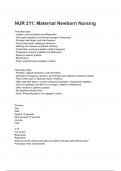NUR 211: Maternal Newborn Nursing
True labor signs
- Leads to cervical dilation and effacement
- Can begin irregularly, but become stronger in frequency
- Stronger, last longer, and more frequent
- Felt in lower back, radiating to abdomen
- Walking can increase contraction intensity
- Contractions continues despite comfort measures
- Progressive change in dilation and effacement
- Moves to anterior position
- Bloody show
- Fetus: presenting part engages in pelvis
False labor signs
- Painless, irregular frequency, and intermittent
- Decrease in frequency, duration, and intensity with walking or position changes
- Felt in lower back or abdomen above umbilicus
- Often stop with sleep or comfort measures (hydration, emptying the bladder)
- Cervix is assesses and little to no change in dilation or effacement
- Often remains in posterior position
- No significant bloody show
- Fetus: Presenting part is not engaged in pelvis
Previous
Play
Next
Rewind 10 seconds
Move forward 10 seconds
Unmute
0:00
/
0:15
Full screen
Brainpower
Read More
What are the five factors that affect and define the labor and birth process?
Passenger: fetus and placenta
,Passageway: the birth canal
Powers: contractions
Position: of the woman
Psychological response
Passenger
The size of the fetal head, fetal presentation, fetal lie, fetal attitude, and fetal position affect the
ability of the fetus to navigate the birth canal.
Fetal presentation (under Passenger)
This part of the fetus that is entering the pelvic inlet first and leads through the birth canal during
labor. It can be....
- the back of the head, occiput
- the chin, mentum
- the shoulder, scapula
or
- breech, sacrum or feet
Fetal lie (under Passenger/Presentation subcategory)
The relationship of the maternal longitudinal axis (spine) to the fetal longitudinal axis (spine).
- Transverse; think of a cross (perpendicular); will not accommodate vaginal birth; c/s
- Parallel/longitudinal (most common; expected)
Fetal attitude (under Passenger)
Relationship of fetal body parts to one another
Fetal flexion: Chin flexed to chest, extremities flexed into torso
Fetal extension: Chin extended away from chest, extremities extended
Fetopelvic or fetal position (under Passenger):
The relationship of the presenting part of the fetus (sacrum, mentum, or occiput), preferably the
occiput, in reference to its directional position as it relates to one of the four maternal pelvic
quadrants. It is labeled with three letters.
- Right (R) or Left (L): references the side of the maternal pelvis
, - Occiput (O), sacrum (S), mentum (M), or scapula (Sc): the second letter references the
presenting part of the fetus
- Anterior (A), posterior (P), or transverse (T): the third letter references the part of the maternal
pelvis
Station (under Passenger)
Measurement of fetal descent in centimeters with station 0 being at the level of an imaginary
line at the level of the ischial spines, minus stations superior to the ischial spines, and plus
stations inferior to the ischial spines
Passageway
The birth canal that is composed of the bony pelvis, cervix, pelvic floor, vagina, and introitus
(vaginal opening)
Powers
Uterine contractions cause effacement (shortening and thinning of the cervix) during the first
stage of labor and dilation of the cervix (enlargement or widening of the cervical opening and
canal) that occurs once labor has begun and the fetus is descending. Involuntary urge to push
and voluntary bearing down in the second stage of labor helps in the expulsion of the fetus.
Position
The client should engage in frequent position changes during labor to increase comfort, relieve
fatigue, and promote circulation.
Position during the second stage is determined by maternal preference, provider preference,
and the condition of the monitor and fetus
Psychological response
Maternal stress, tension, and anxiety can produce physiological changes that impair the
progress of labor
Stages of labor
First stage (Latent, Active, Transition)
Second stage (30-2hr)
Third stage (5-30 min)
Fourth stage (1-2 hr)




